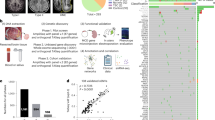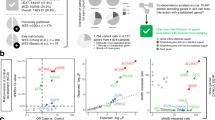Abstract
Focal cortical dysplasia type II (FCDII) is a sporadic developmental malformation of the cerebral cortex characterized by dysmorphic neurons, dyslamination and medically refractory epilepsy1,2. It has been hypothesized that FCD is caused by somatic mutations in affected regions3,4. Here, we used deep whole-exome sequencing (read depth, 412–668×) validated by site-specific amplicon sequencing (100–347,499×) in paired brain-blood DNA from four subjects with FCDII and uncovered a de novo brain somatic mutation, mechanistic target of rapamycin (MTOR) c.7280T>C (p.Leu2427Pro) in two subjects. Deep sequencing of the MTOR gene in an additional 73 subjects with FCDII using hybrid capture and PCR amplicon sequencing identified eight different somatic missense mutations found in multiple brain tissue samples of ten subjects. The identified mutations accounted for 15.6% of all subjects with FCDII studied (12 of 77). The identified mutations induced the hyperactivation of mTOR kinase. Focal cortical expression of mutant MTOR by in utero electroporation in mice was sufficient to disrupt neuronal migration and cause spontaneous seizures and cytomegalic neurons. Inhibition of mTOR with rapamycin suppressed cytomegalic neurons and epileptic seizures. This study provides, to our knowledge, the first evidence that brain somatic activating mutations in MTOR cause FCD and identifies mTOR as a treatment target for intractable epilepsy in FCD.
This is a preview of subscription content, access via your institution
Access options
Subscribe to this journal
Receive 12 print issues and online access
$209.00 per year
only $17.42 per issue
Buy this article
- Purchase on SpringerLink
- Instant access to full article PDF
Prices may be subject to local taxes which are calculated during checkout



Similar content being viewed by others
Accession codes
Primary accessions
Sequence Read Archive
References
Bast, T., Ramantani, G., Seitz, A. & Rating, D. Focal cortical dysplasia: prevalence, clinical presentation and epilepsy in children and adults. Acta Neurol. Scand. 113, 72–81 (2006).
Taylor, D.C., Falconer, M.A., Bruton, C.J. & Corsellis, J.A. Focal dysplasia of the cerebral cortex in epilepsy. J. Neurol. Neurosurg. Psychiatry 34, 369–387 (1971).
Crino, P.B. Focal brain malformations: seizures, signaling, sequencing. Epilepsia 50 (suppl. 9), 3–8 (2009).
Poduri, A., Evrony, G.D., Cai, X. & Walsh, C.A. Somatic mutation, genomic variation, and neurological disease. Science 341, 1237758 (2013).
Krsek, P. et al. Different features of histopathological subtypes of pediatric focal cortical dysplasia. Ann. Neurol. 63, 758–769 (2008).
Fauser, S. et al. Focal cortical dysplasias: surgical outcome in 67 patients in relation to histological subtypes and dual pathology. Brain 127, 2406–2418 (2004).
Blümcke, I. et al. The clinicopathologic spectrum of focal cortical dysplasias: a consensus classification proposed by an ad hoc Task Force of the ILAE Diagnostic Methods Commission. Epilepsia 52, 158–174 (2011).
Fauser, S. et al. Clinical characteristics in focal cortical dysplasia: a retrospective evaluation in a series of 120 patients. Brain 129, 1907–1916 (2006).
Chen, J. et al. Detection of human papillomavirus in human focal cortical dysplasia type IIB. Ann. Neurol. 72, 881–892 (2012).
Sisodiya, S.M., Fauser, S., Cross, J.H. & Thom, M. Focal cortical dysplasia type II: biological features and clinical perspectives. Lancet Neurol. 8, 830–843 (2009).
Colombo, N. et al. Focal cortical dysplasia type IIa and IIb: MRI aspects in 118 cases proven by histopathology. Neuroradiology 54, 1065–1077 (2012).
Cibulskis, K. et al. Sensitive detection of somatic point mutations in impure and heterogeneous cancer samples. Nat. Biotechnol. 31, 213–219 (2013).
Kim, S. et al. Virmid: accurate detection of somatic mutations with sample impurity inference. Genome Biol. 14, R90 (2013).
Robasky, K., Lewis, N.E. & Church, G.M. The role of replicates for error mitigation in next-generation sequencing. Nat. Rev. Genet. 15, 56–62 (2014).
Shirley, M.D. et al. Sturge-Weber syndrome and port-wine stains caused by somatic mutation in GNAQ. N. Engl. J. Med. 368, 1971–1979 (2013).
Williams, C. et al. A high frequency of sequence alterations is due to formalin fixation of archival specimens. Am. J. Pathol. 155, 1467–1471 (1999).
Grabiner, B.C. et al. A diverse array of cancer-associated MTOR mutations are hyperactivating and can predict rapamycin sensitivity. Cancer Discov. 4, 554–563 (2014).
Yang, H. et al. mTOR kinase structure, mechanism and regulation. Nature 497, 217–223 (2013).
Urano, J. et al. Point mutations in TOR confer Rheb-independent growth in fission yeast and nutrient-independent mammalian TOR signaling in mammalian cells. Proc. Natl. Acad. Sci. USA 104, 3514–3519 (2007).
Crino, P.B. mTOR: A pathogenic signaling pathway in developmental brain malformations. Trends Mol. Med. 17, 734–742 (2011).
Navarro-Quiroga, I., Chittajallu, R., Gallo, V. & Haydar, T.F. Long-term, selective gene expression in developing and adult hippocampal pyramidal neurons using focal in utero electroporation. J. Neurosci. 27, 5007–5011 (2007).
Rivière, J.B. et al. De novo germline and postzygotic mutations in AKT3, PIK3R2 and PIK3CA cause a spectrum of related megalencephaly syndromes. Nat. Genet. 44, 934–940 (2012).
Poduri, A. et al. Somatic activation of AKT3 causes hemispheric developmental brain malformations. Neuron 74, 41–48 (2012).
Lee, J.H. et al. De novo somatic mutations in components of the PI3K–AKT3-mTOR pathway cause hemimegalencephaly. Nat. Genet. 44, 941–945 (2012).
Reumers, J. et al. Optimized filtering reduces the error rate in detecting genomic variants by short-read sequencing. Nat. Biotechnol. 30, 61–68 (2012).
Krueger, D.A. et al. Everolimus for subependymal giant-cell astrocytomas in tuberous sclerosis. N. Engl. J. Med. 363, 1801–1811 (2010).
Krueger, D.A. et al. Everolimus treatment of refractory epilepsy in tuberous sclerosis complex. Ann. Neurol. 74, 679–687 (2013).
Aronica, E., Becker, A.J. & Spreafico, R. Malformations of cortical development. Brain Pathol. 22, 380–401 (2012).
Crino, P.B., Nathanson, K.L. & Henske, E.P. The tuberous sclerosis complex. N. Engl. J. Med. 355, 1345–1356 (2006).
Feliciano, D.M., Su, T., Lopez, J., Platel, J.C. & Bordey, A. Single-cell Tsc1 knockout during corticogenesis generates tuber-like lesions and reduces seizure threshold in mice. J. Clin. Invest. 121, 1596–1607 (2011).
Baybis, M. et al. mTOR cascade activation distinguishes tubers from focal cortical dysplasia. Ann. Neurol. 56, 478–487 (2004).
Miyata, H., Chiang, A.C. & Vinters, H.V. Insulin signaling pathways in cortical dysplasia and TSC-tubers: tissue microarray analysis. Ann. Neurol. 56, 510–519 (2004).
Liu, J. et al. Evidence for mTOR pathway activation in a spectrum of epilepsy-associated pathologies. Acta Neuropathol Commun 2, 71 (2014).
Yasin, S.A. et al. mTOR-dependent abnormalities in autophagy characterize human malformations of cortical development: evidence from focal cortical dysplasia and tuberous sclerosis. Acta Neuropathol. 126, 207–218 (2013).
Becker, A.J. et al. Focal cortical dysplasia of Taylor's balloon cell type: mutational analysis of the TSC1 gene indicates a pathogenic relationship to tuberous sclerosis. Ann. Neurol. 52, 29–37 (2002).
Scheffer, I.E. et al. Mutations in mammalian target of rapamycin regulator DEPDC5 cause focal epilepsy with brain malformations. Ann. Neurol. 75, 782–787 (2014).
Kim, Y.H. et al. Neuroimaging in identifying focal cortical dysplasia and prognostic factors in pediatric and adolescent epilepsy surgery. Epilepsia 52, 722–727 (2011).
Zeng, L.H., Xu, L., Gutmann, D.H. & Wong, M. Rapamycin prevents epilepsy in a mouse model of tuberous sclerosis complex. Ann. Neurol. 63, 444–453 (2008).
Acknowledgements
We thank E.J. Kim, J. Kim and S. Kim at KAIST for stimulating discussion and critical reading of the manuscript, S.M. Park at KAIST for coordinating clinical information, M.H. Kim at KAIST for analyzing behavioral seizures, J.S. Lee at Yonsei University Health System (YUHS) for providing clinical information, and K.L. Guan at the University of California–San Diego for kindly providing Flag-mTOR construct. This work was supported by a grant of the Korean Health Technology Research and Development (R&D) Project, Ministry of Health & Welfare, Republic of Korea (A121070 to J.H. Lee; HI13C0208 to J.H. Lee and D.S. Kim), the Brain Research Program through the National Research Foundation of Korea (NRF) funded by the Ministry of Science, Information and Communication Technology (ICT) & Future Planning (2013M3C7A1056564 to J.H. Lee), and the KAIST Future Systems Healthcare Project from the Ministry of Science, ICT and Future Planning (to H.M. Kim, D. Kim and J.H. Lee).
Author information
Authors and Affiliations
Contributions
J.S.L. organized the project, and J.S.L. and W.K. performed genetic studies. S.H.K. performed pathological studies. H.R. adjusted the condition of deep WES. J.S.L. performed bioinformatics analysis with S.K. and J.K. J.S.L. and W.K. performed immunostaining and in vivo studies. W.K. and Y.-W.C. performed in vitro studies. H.M.K. modeled the three-dimensional structure of mTOR. D.K., A.H.P. and J.S. Lim performed video-EEG recording and analysis of seizures. D.-S.K. and H.-C.K. performed surgeries, collected patient samples and managed patient information and tissues samples with S.H.K., J.A.K., S.-G.K., E.K.P. and H.D.K. D.-S.K. and J.H.L. led the project and oversaw the manuscript preparation.
Corresponding authors
Ethics declarations
Competing interests
The authors declare no competing financial interests.
Supplementary information
Supplementary Text and Figures
Supplementary Tables 1–5 and Supplementary Figures 1–9 (PDF 6971 kb)
Video-EEG monitoring of the spontaneous seizure in mTORp
Leu2427Pro electroporated mouse. (MP4 2129 kb)
Source data
Rights and permissions
About this article
Cite this article
Lim, J., Kim, Wi., Kang, HC. et al. Brain somatic mutations in MTOR cause focal cortical dysplasia type II leading to intractable epilepsy. Nat Med 21, 395–400 (2015). https://doi.org/10.1038/nm.3824
Received:
Accepted:
Published:
Issue Date:
DOI: https://doi.org/10.1038/nm.3824



